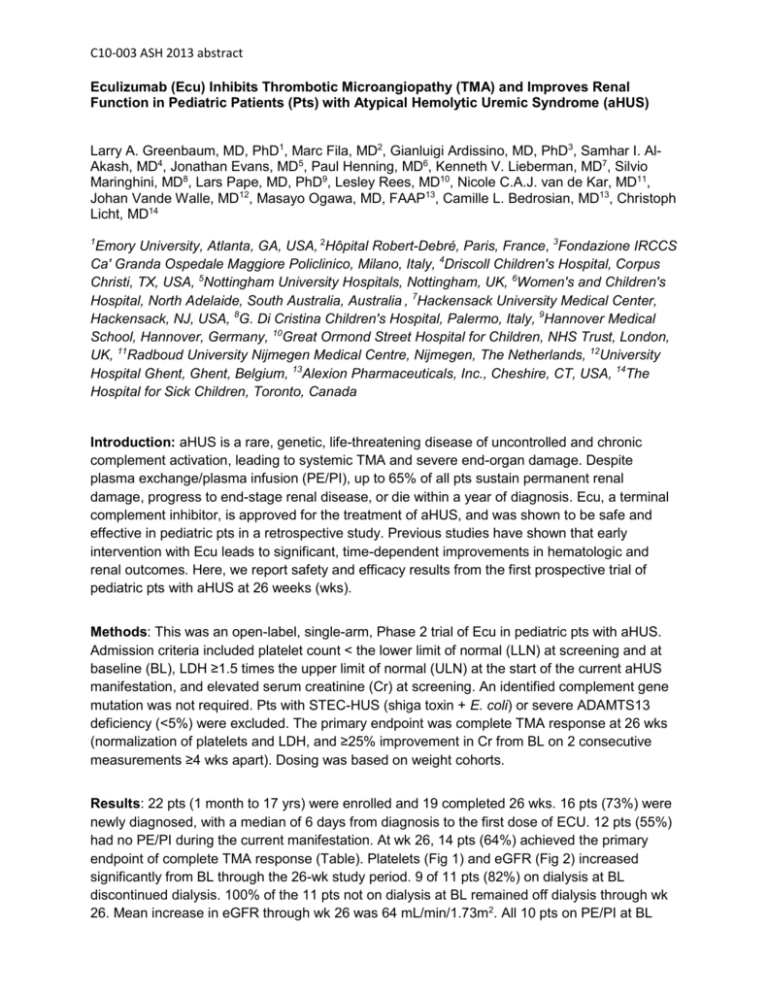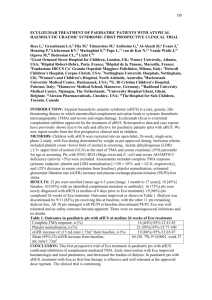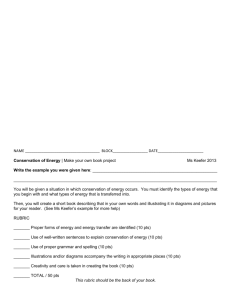full text
advertisement

C10-003 ASH 2013 abstract Eculizumab (Ecu) Inhibits Thrombotic Microangiopathy (TMA) and Improves Renal Function in Pediatric Patients (Pts) with Atypical Hemolytic Uremic Syndrome (aHUS) Larry A. Greenbaum, MD, PhD1, Marc Fila, MD2, Gianluigi Ardissino, MD, PhD3, Samhar I. AlAkash, MD4, Jonathan Evans, MD5, Paul Henning, MD6, Kenneth V. Lieberman, MD7, Silvio Maringhini, MD8, Lars Pape, MD, PhD9, Lesley Rees, MD10, Nicole C.A.J. van de Kar, MD11, Johan Vande Walle, MD12, Masayo Ogawa, MD, FAAP13, Camille L. Bedrosian, MD13, Christoph Licht, MD14 1 Emory University, Atlanta, GA, USA, 2Hôpital Robert-Debré, Paris, France, 3Fondazione IRCCS Ca' Granda Ospedale Maggiore Policlinico, Milano, Italy, 4Driscoll Children's Hospital, Corpus Christi, TX, USA, 5Nottingham University Hospitals, Nottingham, UK, 6Women's and Children's Hospital, North Adelaide, South Australia, Australia , 7Hackensack University Medical Center, Hackensack, NJ, USA, 8G. Di Cristina Children's Hospital, Palermo, Italy, 9Hannover Medical School, Hannover, Germany, 10Great Ormond Street Hospital for Children, NHS Trust, London, UK, 11Radboud University Nijmegen Medical Centre, Nijmegen, The Netherlands, 12University Hospital Ghent, Ghent, Belgium, 13Alexion Pharmaceuticals, Inc., Cheshire, CT, USA, 14The Hospital for Sick Children, Toronto, Canada Introduction: aHUS is a rare, genetic, life-threatening disease of uncontrolled and chronic complement activation, leading to systemic TMA and severe end-organ damage. Despite plasma exchange/plasma infusion (PE/PI), up to 65% of all pts sustain permanent renal damage, progress to end-stage renal disease, or die within a year of diagnosis. Ecu, a terminal complement inhibitor, is approved for the treatment of aHUS, and was shown to be safe and effective in pediatric pts in a retrospective study. Previous studies have shown that early intervention with Ecu leads to significant, time-dependent improvements in hematologic and renal outcomes. Here, we report safety and efficacy results from the first prospective trial of pediatric pts with aHUS at 26 weeks (wks). Methods: This was an open-label, single-arm, Phase 2 trial of Ecu in pediatric pts with aHUS. Admission criteria included platelet count < the lower limit of normal (LLN) at screening and at baseline (BL), LDH ≥1.5 times the upper limit of normal (ULN) at the start of the current aHUS manifestation, and elevated serum creatinine (Cr) at screening. An identified complement gene mutation was not required. Pts with STEC-HUS (shiga toxin + E. coli) or severe ADAMTS13 deficiency (<5%) were excluded. The primary endpoint was complete TMA response at 26 wks (normalization of platelets and LDH, and ≥25% improvement in Cr from BL on 2 consecutive measurements ≥4 wks apart). Dosing was based on weight cohorts. Results: 22 pts (1 month to 17 yrs) were enrolled and 19 completed 26 wks. 16 pts (73%) were newly diagnosed, with a median of 6 days from diagnosis to the first dose of ECU. 12 pts (55%) had no PE/PI during the current manifestation. At wk 26, 14 pts (64%) achieved the primary endpoint of complete TMA response (Table). Platelets (Fig 1) and eGFR (Fig 2) increased significantly from BL through the 26-wk study period. 9 of 11 pts (82%) on dialysis at BL discontinued dialysis. 100% of the 11 pts not on dialysis at BL remained off dialysis through wk 26. Mean increase in eGFR through wk 26 was 64 mL/min/1.73m2. All 10 pts on PE/PI at BL C10-003 ASH 2013 abstract discontinued PE/PI. QoL significantly improved. Ecu was safe and well tolerated. 1 pt withdrew due to an SAE (agitation). No pts had meningococcal infection or died. Conclusions: In this, the first prospective trial of pediatric pts with aHUS, early intervention with Ecu improved hematologic and renal parameters. 82% of pts discontinued dialysis, and no pt initiated dialysis during the 26-wk study. Use of Ecu has been recommended as first-line therapy in children with aHUS. This trial confirms that Ecu inhibits complement-mediated TMA, and is safe and effective as first-line therapy at the approved dose regimen in pediatric pts with aHUS. Treatment in this clinical trial is ongoing. Table Baseline Demographics and Disease Characteristics (N=22) Age, mean (SD), y 6.6 (6.1) Female sex, n (%) 10 (45) Identified complement regulatory protein mutation or auto-antibody, n (%) 10 (45) Time from aHUS diagnosis until screening (mo), median (range) Duration of current clinical manifestation of aHUS (mo), median (range) Dialysis at baseline, n (%) Prior renal transplant, n (%) 0.56 (0.03–191.3) 0.2 (0.0–4.3) 11 (50.0) 2 (9) Platelet count <150x109/L, n (%) 22 (100) LDH >ULN, n (%) 19 (86) eGFR ≤60 mL/min/1.73m2,n (%) 18 (82) Efficacy Outcomes at Wk 26 Complete TMA response*, n (%) 14 (64) Complete hematologic response†, n (%) 18 (82) Platelet count normalization‡ , n (%) 21 (95) eGFR improvement from baseline ≥15 mL/min/1.73m 2, n (%) 19 (86) eGFR increase from baseline (mL/min/1.73 m 2), mean (95% CI) Serum creatinine ≥25% decrease from baseline, n (%) 64 (50; 79) P<0.0001 (wk 25) 16 (73) *Complete TMA response: normalization of platelets and LDH, and ≥25% improvement in Cr from BL on 2 consecutive measurements ≥4 wk apart. † Complete hematologic response: platelet and LDH normalization at ≥2 consecutive measurements ≥4 wk apart. C10-003 ASH 2013 abstract ‡ Platelet count normalization: platelet count ≥150x109/L at ≥2 consecutive measurements ≥4 wk apart. Figure 1: Platelet count improvement through 26 weeks. Figure 2: eGFR improvement through 26 weeks.







